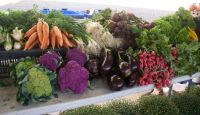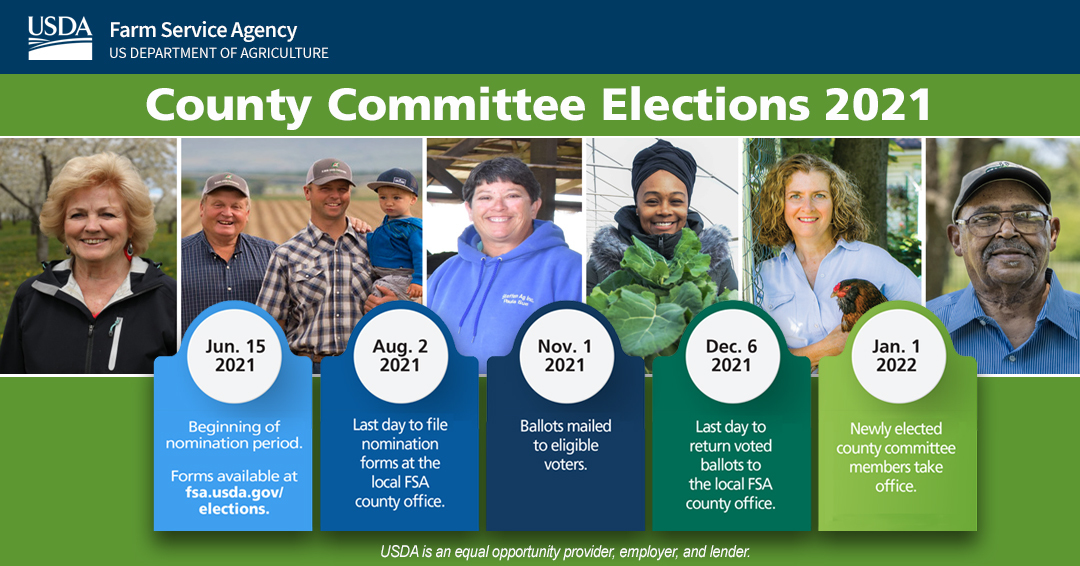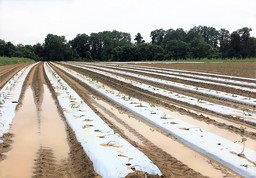In This Issue:

The U.S. Department of Agriculture (USDA) Farm Service Agency (FSA) is still accepting applications for the Coronavirus Food Assistance Program 2 (CFAP 2) as part of the Pandemic Assistance for Producers initiative. No deadline has been announced.
CFAP 2 provides direct financial relief to producers due to market disruptions and associated costs because of COVID-19. CFAP 2 payments will be made for three categories of commodities – Price Trigger Commodities, Flat-rate Crops and Sales Commodities. Producers do not need to have had a loss to qualify for a payment. Visit farmers.gov/cfap/commodities for a full list of eligible commodities for each category.
Price Trigger Commodities Price trigger commodities are major commodities that meet a minimum 5-percent price decline over a specified period of time. Eligible price trigger crops include barley, corn, sorghum, soybeans, sunflowers, upland cotton, and all classes of wheat. Payments will be based on 2020 planted acres of the crop, excluding prevented planting and experimental acres.
For broilers and eggs, payments will be based on 75 percent of the producers’ 2019 production.
Dairy (cow’s milk) payments will be based on actual milk production from April 1 to Aug. 31, 2020. The milk production for Sept. 1, 2020, to Dec. 31, 2020, will be estimated by FSA.
Eligible beef cattle, hogs and pigs, and lambs and sheep payments will be based on the maximum owned inventory of eligible livestock, excluding breeding stock, on a date selected by the producer, between April 16, 2020, and Aug. 31, 2020.
Flat-rate Crops Crops that either do not meet the 5-percent price decline trigger or do not have data available to calculate a price change will have payments calculated based on eligible 2020 acres multiplied by $15 per acre. These crops include alfalfa, extra long staple (ELS) cotton, oats, peanuts, rice, hemp, millet, mustard, safflower, sesame, triticale, rapeseed, and several others.
Sales Commodities Sales commodities include specialty crops; aquaculture; nursery crops and floriculture; other commodities not included in the price trigger and flat-rate categories, turfgrass sod; pullets; goat milk; mink (including pelts); mohair; wool; and other livestock (excluding breeding stock), not included under the price trigger category that were grown for food, fiber, fur, or feathers. Payment calculations will use a sales-based approach, where producers are paid based on five payment gradations associated with their 2019 sales, and crop insurance indemnities, Noninsured Crop Disaster Assistance Program (NAP), and Wildfire and Hurricane Indemnity Program Plus (WHIP+) payments for crop year 2019.
Applying for CFAP 2
Visit farmers.gov/cfap for details on all eligible commodities, producer eligibility, payment limitations and structure and additional program resources.
Producers have multiple options to apply for CFAP 2, including through an online application portal and by working directly with the FSA office. Customers seeking one-on-one support with the CFAP 2 application process can call 877-508-8364 to speak directly with a USDA employee ready to offer assistance.
Additional CFAP Payments for Beef and Row-Crop Producers
The Consolidated Appropriations Act, 2021, authorized an increase in CFAP 1 payment rates for cattle. Cattle producers with approved CFAP 1 applications automatically received these payments and do not need to submit a new application since payments are based on previously approved CFAP 1 applications. Producers may be asked for additional information depending on how they filed the original application. Information on the additional payment rates for cattle can be found on farmers.gov/cfap.
This act also authorized additional CFAP assistance of $20 per acre for producers of eligible CFAP 2 flat-rate or price trigger commodities. FSA automatically issued payments to eligible producers based on the eligible acres included on their CFAP 2 applications. Eligible producers do not need to submit a new CFAP 2 application.
Additional CFAP Actions FSA has also begun payment processing applications filed as part of the CFAP Additional Assistance program in the following categories:
- Applications filed for pullets and turfgrass sod;
- A formula correction for row-crop producer applications to allow producers with a non-Actual Production History (APH) insurance policy to use 100% of the 2019 Agriculture Risk Coverage-County Option (ARC-CO) benchmark yield in the calculation; and
- Sales commodity applications revised to include insurance indemnities, Noninsured Crop Disaster Assistance Program payments, and Wildfire and Hurricane Indemnity Program Plus payments.
Additional payments for swine producers and contract growers under CFAP Additional Assistance remain on hold and are likely to require modifications to the regulation as part of the broader evaluation and future assistance; however, FSA will continue to accept applications from interested producers.
|

ECP helps you with the cost to restore the farmland to pre-disaster conditions. You may receive up to 75 percent of the cost of approved restoration activity. Limited resource, socially disadvantaged and beginning farmers and ranchers may receive up to 90 percent cost-share. A 25 percent advance payment will be allowed for repair or replacement of fencing. The payment limitation for ECP is $500,000 per disaster, and the funds are limited to activities to return the land to the relative pre-disaster condition.
You must apply for assistance prior to beginning reconstructive work. FSA’s National Environmental Policy Act (NEPA) and environmental compliance review process is required to be completed before any actions are taken. Submitting an application after reconstructive work has been completed may not qualify for ECP. Conservation concerns that were present on the land prior to the disaster are not eligible for ECP assistance.
FSA county committees will evaluate applications based on an on-site inspection of the damaged land, taking into consideration the type and extent of the damage. An on-site inspection does not guarantee that cost-share funding will be provided.
For more information on ECP visit farmers.gov/recover.
|
If you’re an orchardist or nursery tree grower whose experienced losses from natural disasters during calendar year 2021, you must submit a TAP application either 90 calendar days after the disaster event or the date when the loss is apparent.
TAP provides financial assistance to help you replant or rehabilitate eligible trees, bushes and vines damaged by natural disasters.
Eligible tree types include trees, bushes or vines that produce an annual crop for commercial purposes. Nursery trees include ornamental, fruit, nut and Christmas trees that are produced for commercial sale. Trees used for pulp or timber are ineligible.
To qualify for TAP, orchardists must suffer a qualifying tree, bush or vine loss in excess of 15 percent mortality from an eligible natural disaster, plus an adjustment for normal mortality. The eligible trees, bushes or vines must have been owned when the natural disaster occurred; however, eligible growers are not required to own the land on which the eligible trees, bushes and vines were planted.
If the TAP application is approved, the eligible trees, bushes and vines must be replaced within 12 months from the date the application is approved. The cumulative total quantity of acres planted to trees, bushes or vines, for which you can receive TAP payments, cannot exceed 1,000 acres annually.
The U.S. Department of Agriculture (USDA) is providing up to $200 million to provide relief to timber harvesting and timber hauling businesses that have experienced losses due to COVID-19 as part of USDA’s Pandemic Assistance for Producers initiative. Loggers and truckers can apply for assistance through USDA’s Farm Service Agency (FSA) July 22 through Oct. 15, 2021. The Pandemic Assistance for Timber Harvesters and Haulers program (PATHH) is administered by FSA in partnership with the U.S. Forest Service.
The Consolidated Appropriations Act, 2021, authorized this critical assistance for the timber industry. Timber harvesting and hauling businesses that have experienced a gross revenue loss of at least 10% during the period of Jan. 1 and Dec. 1, 2020, compared to the period of Jan. 1 and Dec. 1, 2019, are encouraged to apply.
Program Details
To be eligible for payments, individuals or legal entities must be a timber harvesting or timber hauling business where 50% or more of its gross revenue is derived from one or more of the following:
- Cutting timber.
- Transporting timber.
- Processing of wood on-site on the forest land (chipping, grinding, converting to biochar, cutting to smaller lengths, etc.).
Payments will be based on the applicant’s gross revenue received from Jan. 1, 2019, through Dec. 1, 2019, minus gross revenue received from Jan. 1, 2020, through Dec. 1, 2020, multiplied by 80%. FSA will issue an initial payment equal to the lesser of the calculated payment amount or $2,000 as applications are approved. A second payment will be made after the signup period has ended based upon remaining PATHH funds.
The maximum amount that a person or legal entity may receive directly is $125,000.
Applying for Assistance
Loggers and truckers can apply for PATHH beginning on July 22 by completing form FSA-1118, Pandemic Assistance for Timber Harvesters and Haulers Program application, and certifying to their gross revenue for 2019 and 2020 on the application. Additional documentation may be required. Visit farmers.gov/pathh for more information on how to apply.
Applications can be submitted to the FSA office at any USDA Service Center nationwide by mail, fax, hand delivery, or via electronic means. To find a local FSA office, loggers and truckers can visit farmers.gov/service-locator. They can also call 877-508-8364 to speak directly with a USDA employee ready to offer assistance.
Livestock and poultry producers who suffered losses during the pandemic due to insufficient access to processing can apply for assistance for those losses and the cost of depopulation and disposal of the animals. The U.S. Department of Agriculture (USDA) Secretary Vilsack announced the Pandemic Livestock Indemnity Program (PLIP) in [recorded] remarks at the National Pork Industry Conference in Wisconsin Dells, WI. The announcement is part of USDA’s Pandemic Assistance for Producers initiative. Livestock and poultry producers can apply for assistance through USDA’s Farm Service Agency (FSA) July 20 through Sept. 17, 2021.
The Consolidated Appropriations Act, 2021, authorized payments to producers for losses of livestock or poultry depopulated from March 1, 2020 through December 26, 2020, due to insufficient processing access as a result of the pandemic. PLIP payments will be based on 80% of the fair market value of the livestock and poultry and for the cost of depopulation and disposal of the animal. Eligible livestock and poultry include swine, chickens and turkeys.
PLIP Program Details
Eligible livestock must have been depopulated from March 1, 2020, through December 26, 2020, due to insufficient processing access as a result of the pandemic. Livestock must have been physically located in the U.S. or a territory of the U.S. at the time of depopulation.
Eligible livestock owners include persons or legal entities who, as of the day the eligible livestock was depopulated, had legal ownership of the livestock. Packers, live poultry dealers and contract growers are not eligible for PLIP.
PLIP payments compensate participants for 80% of both the loss of the eligible livestock or poultry and for the cost of depopulation and disposal based on a single payment rate per head. PLIP payments will be calculated by multiplying the number of head of eligible livestock or poultry by the payment rate per head, and then subtracting the amount of any payments the eligible livestock or poultry owner has received for disposal of the livestock or poultry under the Natural Resources Conservation Service (NRCS) Environmental Quality Incentives Program (EQIP) or a state program. The payments will also be reduced by any Coronavirus Food Assistance Program (CFAP 1 and 2) payments paid on the same inventory of swine that were depopulated.
There is no per person or legal entity payment limitation on PLIP payments. To be eligible for payments, a person or legal entity must have an average adjusted gross income (AGI) of less than $900,000 for tax years 2016, 2017 and 2018.
Applying for Assistance
Eligible livestock and poultry producers can apply for PLIP starting July 20, 2021, by completing the FSA-620, Pandemic Livestock Indemnity Program application, and submitting it to any FSA county office. Additional documentation may be required. Visit farmers.gov/plip for a copy of the Notice of Funding Availability and more information on how to apply.
Applications can be submitted to the FSA office at any USDA Service Center nationwide by mail, fax, hand delivery or via electronic means. To find your local FSA office, visit farmers.gov/service-locator. Livestock and poultry producers can also call 877-508-8364 to speak directly with a USDA employee ready to offer assistance.
 The U.S. Department of Agriculture (USDA) Farm Service Agency (FSA) began accepting nominations for county committee members on June 15. Elections will occur in certain Local Administrative Areas (LAA) for these members who make important decisions about how federal farm programs are administered locally. All nomination forms for the 2021 election must be postmarked or received in the local FSA office by Aug. 2, 2021.
New Jersey specific election information is available on our state website at www.fsa.usda.gov/nj
Agricultural producers who participate or cooperate in a USDA program, and reside in the LAA that is up for election this year, may be nominated for candidacy for the county committee. A cooperating producer is someone who has provided information about their farming or ranching operation to FSA, even if they have not applied or received program benefits. Individuals may nominate themselves or others and qualifying organizations may also nominate candidates. USDA encourages minority producers, women and beginning farmers or ranchers to nominate, vote, and hold office.
Nationwide, more than 7,700 dedicated members of the agricultural community serving on FSA county committees. The committees are made up of three to 11 members who serve three-year terms. Producers serving on FSA county committees play a critical role in the day-to-day operations of the agency. Committee members are vital to how FSA carries out disaster programs, as well as conservation, commodity and price support programs, county office employment and other agricultural issues.
LAAs are elective areas for FSA committees in a single county or multi-county jurisdiction. This may include LAAs that are focused on an urban or suburban area.
More Information
Producers should contact their local FSA office today to register and find out how to get involved in their county’s election. They should check with their local USDA Service Center to see if their LAA is up for election this year. To be considered, a producer must be registered and sign an FSA-669A nomination form or an FSA-669-A-3 for urban county committees. The form and other information about FSA county committee elections are available at fsa.usda.gov/elections.
Election ballots will be mailed to eligible voters beginning Nov. 1, 2021. To find your local USDA Service Center, visit farmers.gov/service-locator.

USDA Farm Service Agency (FSA) reminds producers to file Notices of Loss for prevented planting, failed acres, and yield losses in order to establish or retain FSA program eligibility for some programs.
Prevented Planting
Producers should report crop acreage they intended to plant, but due to natural disaster, were prevented from planting. Prevented planting acreage must be reported on form CCC-576, Notice of Loss, no later than 15 calendar days after the final planting date as established by FSA and Risk Management Agency (RMA).
Contact your local FSA office for a list of final planting dates by crop.
If a producer is unable to report the prevented planting acreage within the 15 calendar days following the final planting date, a late-filed report can be submitted. Late-filed reports will only be accepted if FSA conducts a farm visit to assess the eligible disaster condition that prevented the crop from being planted. A measurement service fee will be charged.
Failed Acres
Additionally, producers with failed acres should also use form CCC-576, Notice of Loss, to report failed acres.
Yield Losses
For losses on crops covered by the Non-Insured Crop Disaster Assistance Program (NAP), producers must file a Notice of Loss within 15 days of the occurrence of the disaster or when losses become apparent. Producers must timely file a Notice of Loss for failed acres on all crops including grasses.
The CCC-576, Notice of Loss, is used to report failed acreage and prevented planting and may be completed by any producer with an interest in the crop. Timely filing a Notice of Loss is required for all crops including grasses. For losses on crops covered by the Non-Insured Crop Disaster Assistance Program (NAP), you must file a CCC-576, Notice of Loss, in the FSA County Office within 15 days of the occurrence of the disaster or when losses become apparent or 15 calendar days after the normal harvest date.
Producers of hand-harvested crops must notify FSA of damage or loss through
the administrative County Office within 72 hours of the date of damage or loss first becomes apparent. Additionally, this requirement is applicable to other crops as determined by the Deputy Administrator of Farm Programs. Please contact your local office if you have questions about specific crops.
This notification can be provided by filing a CCC-576, email, fax or phone. Producers who notify the County Office by any method other than by filing the CCC-576 are still required to file a CCC-576, Notice of Loss, within the required 15 calendar days.
NAP Participants should be sure to review the NAP Basic Provisions found here.
|
|